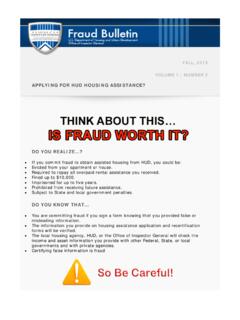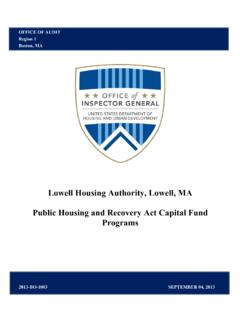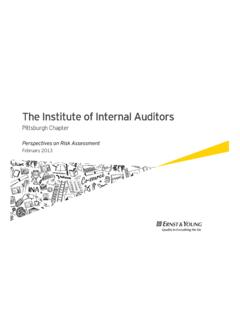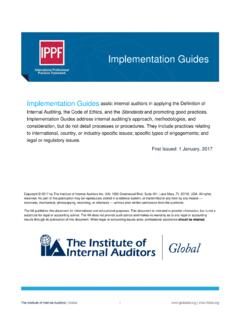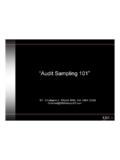Transcription of Implementing the Five Key Internal Controls
1 1 Implementing the Five Key Internal Controls Purpose Internal Controls are processes put into place by management to help an organization operate efficiently and effectively to achieve its objectives. Managers often think of Internal Controls as the purview and responsibility of accountants and auditors . The fact is that management at all levels of an organization is responsible for ensuring that Internal Controls are set up, followed, and reviewed regularly. The purposes of Internal Controls are to: Protect assets; Ensure that records are accurate; Promote operational efficiency; Achieve organizational mission and goals; and Ensure compliance with policies, rules, regulations, and laws.
2 In administering various Department of Housing and Urban Development (HUD), Office of Community Planning and Development (CPD) programs, all grantee and subrecipient organizations deal with risks to achieving their organizational and programmatic goals. No rules, bad rules, or failure to follow rules disrupt the effectiveness of the Internal Controls and, ultimately, mission delivery. This bulletin explains the five Internal control standards and ways to implement them effectively. It also provides case examples of deficiencies in Internal Controls and how those issues could have been avoided through use of Internal Controls . Background If your grant or subgrant is subject to the uniform administrative requirements of 2 Code of Federal Regulations (CFR) Part 200, then 2 CFR requires that your organization follow one of the two approved Internal control frameworks.
3 The Government Accountability Office (GAO) Standards for Internal Control in the Federal Government (commonly called the Green Book ) is one of the frameworks, and the Committee of Sponsoring Organizations (COSO) has issued the other. The former is used by the federal government, while publicly held companies use the latter. Both GAO and COSO provide a framework for designing, Implementing , and operating an effective Internal control system. Using either will help achieve your objectives related to operations, reporting, and compliance. The frameworks have 5 components of Internal control and 17 sub-principles. Fall 2016 2 These standards are the foundation of good management and are described in more detail below.
4 Key 1. Establish a Control Environment The control environment is the culture, values, and expectations that organizations put into place. Ways to establish and nourish the environment are: Set tone at the top by Implementing and promoting ethical standards, integrity, and accountability policies; Set mission, goals and objectives (strategic planning) so the organization knows what it is to accomplish; Establish structure, organizational responsibilities, and reporting chains; Hire competent and trustworthy staff members and provide necessary training for them; Provide leadership and good governance by staying on top of operations and performance, and correcting problems when identified; Emphasize that compliance with laws and regulations is the expectation for the organization.
5 Assure that goals and objectives are clear (especially when there are multiple grant awards) and not in competition with each other or compliance requirements; and Hold people accountable for their responsibilities. Example of weak control environment An audit of a grantee found deficiencies in six of seven contracts reviewed. Problems included insufficient evidence that contracts were adequately competed, missing Summary of Internal Control Standards 1. Control EnvironmentDemonstrate commitment to integrity and ethical valuesEnsure that board exercises oversight responsibilityEstablish structures, reporting lines, authorities and responsibilitiesDemonstrate commitment to a competent workforceHold people accountable2.
6 Risk AssessmentSpecify appropriate objectivesIdentify and analyze risksEvaluate fraud risksIdentify and analyze changes that could significantly affect Internal controls3. Control ActivitiesSelect and develop control activities that mitigate risksSelect and develop technology controlsDeploy control activities through policies and procedures4. Information and CommunicationUse relevant, quality information to support the Internal control functionCommunicate Internal control information internallyCommunicate Internal control information externally5. MonitoringPerform ongoing and periodic evaluations of Internal Controls including external auditsCommunicate Internal control deficiencies and assure timely corrective action 3 contract forms and provisions, lack of justification supporting sole-source contracts, and board of commissioners approvals signed after contract execution or missing.
7 Further, auditors discovered that forms were added to the contract files after the request to review them and evidenced the use of correction fluid to conceal the date printed. The executive director acknowledged that the former purchasing director removed files from the organization. The executive director decided to create or reproduce the documentation before giving the files to the auditor. The audit recommended referral of the executive director to HUD s Departmental Enforcement Center for appropriate action regarding the questionable ethical conduct. The agency should have had policies concerning documentation, record archival, and removal of official records from the office.
8 Key 2. Conduct Risk Assessments In the past, risk management focused exclusively on financial dangers. Enterprise Risk Management (ERM) looks at the entirety of an organization and everything that could affect it. Leadership should oversee a risk management process and ways to accomplish this are: Have each function identify the risks to operations and performance; Brainstorm with staff to determine possible external risks (See the appendix at the end of the bulletin that shows examples of types of risks); Learn about emerging risks through employee and customer surveys, etc.; Consider the potential for fraud when identifying, analyzing and responding to risks; Rate and rank the risks, and discuss Controls or other actions needed to eliminate or reduce the risk; Develop corrective actions and assign someone to be in charge of Implementing each.
9 Key 3. Implement Control Activities Control activities are the policies and procedures put into place to run operations, accomplish goals, and prevent fraud. Basic Internal control methods are: Establish responsibility; o Assign each task to only one person. o Establish organizational structure. Implement separation of duties; o Don t make one employee responsible for all parts of a process. o Use compensating Controls , such as additional monitoring or secondary sign-offs, when separation is not possible. Restrict Access; o Don t provide access to systems, information, assets, etc. unless needed. Create policies and procedures; o Implement written instructions with directives to follow them.
10 O Assure Controls cover all areas of compliance. o Assure Controls cover security of assets and technology. Establish record keeping; o Document all expenditures and the justifications for them. Example of lack of control activities A grantee city spent $284,649 in program funds on projects that did not have required executed written agreements with its Internal departments and subrecipients. Agreements or memorandums of understanding for these projects should have included the purpose statements and the national objectives they would meet. This condition occurred because 4 the city did not have Internal Controls to ensure that Internal departments and subrecipients signed agreements before spending program funds.

